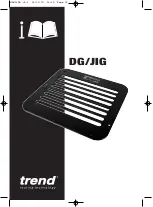
36
a protractor scale). Following one of the above
procedures, hold the base plate in position and
firmly tighten the bolts to clamp the base plate at
that angle. Finally, check the angle and ensure the
base plate is firmly clamped. The angle markings
on the base plate are accurate for most general
purposes but it is recommended for accurate work
to set the angle with a protractor and make a test
cut on other material.
I
8
J
7
12. DUST TUBE (SEE FIG. K)
Mount the dust tube (6) into the opening of the
base plate (7). Make sure that the plastic tip
of the vacuum connection engages into the
corresponding opening on the housing as shown
in the figure.
K
8
13. FINGER PROTECTION
The finger protection is located in front of the
blade holder. Whilst working, it will help prevent
accidental contact with moving blade.
14. DUST BLOWER AIR HOLE
This is a small aperture located underneath the
housing just behind the blade guide. Ensure this is
kept clean to allow the air flow to continually blow
dust away from the cutting area.
15. WORK LIGHT
Press the on/off switch (2), the work light(14)will
illuminate. Release the on/off switch to turn off the
work light.
Caution: Do not look into the strong light or
see the source of light directly.
WORKING HINTS FOR
YOUR JIG SAW
If your jig saw becomes too hot, especially when
used at low speed, set the speed to maximum
and run no Load for 2-3 minutes to cool the motor.
Avoid prolonged usage at very low speeds.
GENERAL
Always use a blade suited to the material and
material thickness to be cut. Always ensure the
work–piece is firmly held or clamped to prevent
movement. For easier control, use low speed to
start cutting, then increase to correct speed.
Any movement of the material may affect the
quality of the cut. The blade cuts on the upward
stroke and may chip the uppermost surface or
face of the work piece. Ensure your uppermost
surface is a non-visible surface when your work is
finished.
CUTTING LAMINATES
Use a fine tooth blade when cutting most
laminates and thin wood materials. To reduce
edge chipping, clamp pieces of waste wood at
both ends on both sides and cut through the
waste wood during cutting.
CIRCLE CUTTING
Do not use the pendulum action when cutting tight
circles or angles
PLUNGE SAWING
Plunge cutting may be used only on soft materials
such as wood, aerated concrete, gypsum plaster
boards, etc.









































